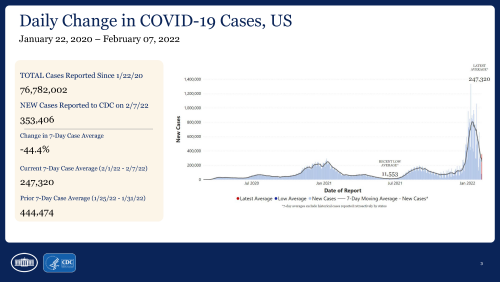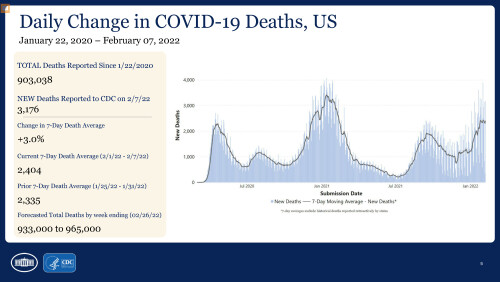Dr. Ella's What We Know Now - February 2022 Covid Update
 The latest surge in the CoVID-19 pandemic started in early December 2021 when the first case of the Omicron variant was diagnosed in California. Omicron quickly proved to be highly transmissible as infections rose with alarming speed across our population, regardless of age or vaccination status. When this surge peaked mid-January 2022, the U.S. was reporting 807,000 new cases per day, which far exceeded daily case numbers recorded at any other time since the beginning of the pandemic in December 2019. Since that peak, daily numbers of new infections, hospitalizations, and deaths have steadily decreased; this week the average of new cases is down 44% to 247,300 per day, hospitalizations are down 25% to 13,000 per day, and deaths are down to 2,400 PER DAY.
The latest surge in the CoVID-19 pandemic started in early December 2021 when the first case of the Omicron variant was diagnosed in California. Omicron quickly proved to be highly transmissible as infections rose with alarming speed across our population, regardless of age or vaccination status. When this surge peaked mid-January 2022, the U.S. was reporting 807,000 new cases per day, which far exceeded daily case numbers recorded at any other time since the beginning of the pandemic in December 2019. Since that peak, daily numbers of new infections, hospitalizations, and deaths have steadily decreased; this week the average of new cases is down 44% to 247,300 per day, hospitalizations are down 25% to 13,000 per day, and deaths are down to 2,400 PER DAY.
 As tens of millions of people were infected over the past ten weeks, we witnessed a jarring rise in hospitalizations and deaths across our country. December 14, 2021, marked 800,000 CoVID-19-related deaths in the U.S.; just 51 days later, on February 4, 2022, we learned that an additional 100,000 people had died. Today, when the number of human deaths was recorded as 914,358, I was reminded of the words of a former professor who said, “Statistics are human beings with the tears removed.” Sheer numbers and assigned categories might enable us to comfortably distance ourselves from others. May we seek to remember that each of these numbers represent one who lived and breathed among us with stories, struggles, hopes, and disappointments as neighbor, friend, mother, father, sibling, partner, child, or elder.
As tens of millions of people were infected over the past ten weeks, we witnessed a jarring rise in hospitalizations and deaths across our country. December 14, 2021, marked 800,000 CoVID-19-related deaths in the U.S.; just 51 days later, on February 4, 2022, we learned that an additional 100,000 people had died. Today, when the number of human deaths was recorded as 914,358, I was reminded of the words of a former professor who said, “Statistics are human beings with the tears removed.” Sheer numbers and assigned categories might enable us to comfortably distance ourselves from others. May we seek to remember that each of these numbers represent one who lived and breathed among us with stories, struggles, hopes, and disappointments as neighbor, friend, mother, father, sibling, partner, child, or elder.
As each month passes, we learn more about this novel coronavirus (SARS-CoV-2) and how it replicates, mutates, responds to treatments and vaccines, and impacts our bodies. We have learned that masking, physical distancing, frequent hand-washing/sanitizing, and effective ventilation clearly make a difference in viral transmission. Eligible adults 18 and older have access to three vaccines (Pfizer, Moderna, and Johnson & Johnson); eligible children and adolescents between ages 5 and 17 have access to the Pfizer vaccine. Pfizer booster doses are available for those ages 12 and above.
Currently 64.4% of the eligible U.S. population (ages 5 and above) has completed their primary vaccine series; 27.3% of those eligible for a booster have obtained one. Individuals 65 years and older have a vaccination series completion rate of 80%. (It is important to look for completed-series data when assessing vaccination uptake.) We are just beginning to see important data from studies designed to determine how long protective antibodies are retained in our bodies in each of the following situations: 1) CoVID-19 infection with no post-infection vaccine; 2) No CoVID-19 infection and completion of a primary vaccine series; 3) No CoVID-19 infection and completion of a primary vaccine series plus booster; and 4) CoVID-19 infection with subsequent completion of a primary vaccine series plus booster. These studies will help determine vaccine/booster guidelines for the future. Of note, last month the CDC issued a vaccine update stating that a second booster may be indicated for those over age 65 and or specific immunocompromised individuals.
Per the CDC, “Efforts to maximize the proportion of people in the U.S. who are up to date with their CoVID-19 vaccines and boosters remain critical to ending the pandemic.” The Omicron surge of the past ten weeks has demonstrated that the vast majority of those who were hospitalized or who died were unvaccinated and/or immunocompromised (transplant, cancer, medication-induced, age).
While the current overall trend of decreasing cases and hospitalizations is encouraging, we must understand that all parts of our country are not moving at the same pace. The Omicron wave started in some places later than others. Those places are still peaking in hospitalizations, overwhelmed health care systems, and death rates previously unseen by most of us; however, the public story is transitioning to talk of a return to normalcy, changing from a pandemic to an endemic, suspending proven public health interventions, and getting on with life. During the CoVID-19 White House Briefing today, Dr. Rochelle Walensky, Director of the CDC, announced that it is still too early to abandon effective preventative measures such as masking in the face of a still-peaking Omicron surge. The desire for transition is fully understandable as we enter our third year of life in a time of pandemic …and the need to be well-informed is essential when we strive to live responsibly in community together.
What We Need to Know Now:
- Follow a website that provides daily updates about the level of Omicron transmission in your county. The current model places counties into one of four transmission categories (Low, Moderate, Substantial and High) based on the number of CoVID-19 cases per 100,000 residents. If you were to look at today’s county maps in Delaware, the District of Columbia, Maryland, or West Virginia, you would see that our entire region is High Level (red), indicating we have more than 100 cases per 100,000 residents. A good site to use is the CDC County Check Widget.
- Become familiar with the county and state governmental entities that make and communicate decisions regarding CoVID-19 in your area. Sign up for updates and public announcements.
- Be clear about exactly what to do if you test positive or are exposed to someone who tests positive for CoVID-19. There are step-by-step CDC guidelines, based on vaccination status, in the section of their website entitled “How to Protect Yourself and Others.” For example, clear definitions of “Quarantine” and “Isolation” are provided. Should you become symptomatic and test positive, be in touch with your primary care provider immediately to discuss whether you may be eligible for any of the early-intervention treatments that limit the duration and seriousness of your infection. The oral agents (Paxlovid, 3 pills twice daily for five days or Molnupiravir, 4 pills twice daily for 5 days) are in short supply in many local pharmacies. Each requires a prescription but is free of charge to consumers. The key is to start the treatment within 3-5 days from the first day of symptoms.
- Secure masks that offer the best protection you can afford. N-95 and KN-95 masks offer 95% protection via multiple layers of material that will contain droplets from your nose and mouth and prevent entry of droplets from others. A limited supply of three N-95 masks per person is being provided at no charge by the government through local pharmacies as inventory becomes available. Supply and cost are important concerns. If you cannot acquire the recommended masks, the next best option is a paper surgical mask covered by a cloth mask, each offering 50% protection. The key is to find a mask that fits correctly to protect you and others and that can be tolerated for an extended period of time if necessary.
- Home CoVID Testing Kits are available free of charge, four per household, through the Federal Government at the website COVIDtests.gov or call 1-800-232-0233 (TTY 1-888-720-7489) or through local pharmacies that are participating in the government’s distribution plan. If you have insurance, check with your company to see what coverage may be available for kits and on-site tests. Here you will find a list of all FDA approved Home Tests.

Thank you. Ella, for leading us on this informative journey by providing us with the history, medical and resource information for COVID-19.
Thank you for the much needed info as it changes quite frequently.